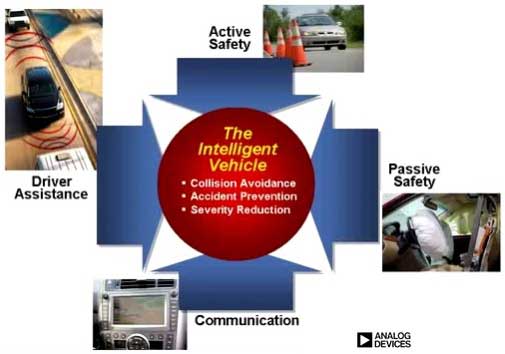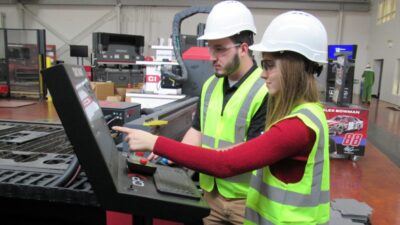Electronic stability control is standard on all Volkswagen 2009 models and after, ahead of the National Highway Traffic Safety Administration’s 2012 mandate. This bit of automation has the potential to save 9,600 lives and prevent up to 238,000 injuries in all types of crashes annually. Audi introduced electronic stability control to the U.S. market in 1999.

Electronic stability control is standard on all Volkswagen 2009 models and after, ahead of the National Highway Traffic Safety Administration’s 2012 mandate. This bit of automation has the potential to save 9,600 lives and prevent up to 238,000 injuries in all types of crashes annually. Audi introduced electronic stability control to the U.S. market in 1999.
While the risk of being injured or killed in a road accident has recently fallen substantially—to the lowest numbers since 1950—safety is still Volkswagen’s top priority, the company said. Volkswagen is developing driver-assistance technologies (vehicle automation) that can reduce the main cause of accidents, driver error. These systems combine production ready video, radar, ultrasonic, electronic horizon, and laser sensor technologies with onboard computing, helping drivers make more informed decisions as they drive.
The latest driver assistance technologies are being designed to take action when the vehicle is at risk of leaving the road or if a collision can no longer be prevented. TAP represents a link between today’s assistance systems and the vision of fully automatic, accident-free driving.
TAP (Temporary Auto Pilot)
Temporary Auto Pilot bundles semi-automatic functions monitored by the driver, with other driver assistance systems, such as ACC (Adaptive Cruise Control) and the Lane Assist (lane-keeping system) into one comprehensive function, allowing the car to drive semi-automatically up to 81 mph.
In the semi- automatic driving mode (Pilot Mode), TAP maintains a safe distance to the vehicle ahead, drives at a speed selected by the driver, reduces this speed as necessary before a bend, and maintains the vehicle’s central position with respect to lane markers. The system also observes overtaking rules and speed limits. Stop and start driving in traffic jams is also automated.
Advanced active safety features include:
- Adaptive Cruise Control—Monitors the distance to vehicles in front via radar
- All-Round Vision—Uses sensor data to detect possible hazards
- Anti-Lock Brake System—Enables steering control while braking
- Anti-Slip Regulation—Prevents loss of wheel traction
- Attention Control—Monitors the driver for signs of fatigue
- Audi Travolution—Enables real-time communication with traffic infrastructure
- Automatic Distance Control—Brings the vehicle to a complete standstill
- Automatic Emergency Brake—Executes a full braking maneuver to prevent a collision
- Autonomous Driving Vehicles—Use laser range-finders and radar sensors
- Back-Up Camera—Makes parking and reversing easier
- Connected Drivers—Assists driver with wireless communication to help avoid potential road hazards
- Dynamic Adaptive Headlights—Sweep around to follow curves
- Electronic Brake-Pressure Distribution—Maximizes braking power
- Electronic Differential Lock—Permits smooth starts on uneven surfaces
- Electronic Stability Control—Reduces skidding and rollovers
- Electronic Steering—Enables independent electronic steering
- Engine Braking Assist—Prevents skidding on slippery surfaces
- Engine Braking Control—Detects the loss of wheel adhesion
- High Beam Assist—Activates and lowers high beams automatically
- Hydraulic Brake Assistant—Shortens braking distance
- Lane Assist—Monitors traffic lines on the pavement and assists the driver to stay in the lane by giving the appropriate warning
- Navigation Companion and Online Portal—Help drivers find, save or share their destinations
- Night Vision—Scans for pedestrians, warns driver with light and sound
- Parking Assist—Automatically maneuvers vehicle into parking space
- Picture Navigation—Allows users to share pictures of destinations with GPS coordinates
- Pre Sense Basic—Activates basic preventive occupant protection systems
- Pre Sense Front—Monitors traffic, warns the driver, increases braking force
- Pre Sense Plus—Activates braking guard, prompts hard braking
- Pre Sense Rear—Scans traffic, moves seats into safest position, inflates seat sides
- Road Sign Display—Registers and displays current speed limits
- Side Assist System—Monitors rear and side blind spots
- Side Lane Change Assist—Warns of vehicles in blind spots
- Sociable Car-Senseable City—Transforms GPS navigation system into a personal co-pilot
- Temporary Auto Pilot—Bundles semi-automatic functions into one comprehensive function
- Voice Activation—Offers a more personalized way to interface in a hands-free mode.
Some of the passive safety features include:
- Driver and passenger front airbags
- Side-impact head and thorax airbags
- Safety belt pre-tensioners
- High-strength safety design for improved crash performance.
Add your comments at the end of this story, Automating Highway Vehicles at Volkswagen. We are interested in hearing what you think about this evolving technology. Click into the link above and scroll down, if you cannot see the comment box below.
GO ROBOTS !
Paul F. Grayson – Chief Engineer
American Industrial Magic
390 4-Mile Rd. S.
Traverse City, MI 49696
(231) 883-4463
[email protected]
https://aimagic.org
https://www.controleng.com/blogs/aiming-for-automated-vehicles.html



